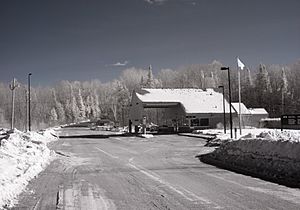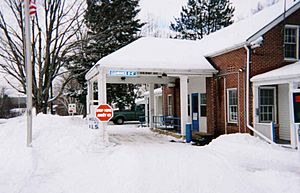Orient–Fosterville Border Crossing facts for kids
Quick facts for kids Orient–Fosterville Border Crossing |
|
|---|---|

The Canada Border Inspection Station at Fosterville, New Brunswick
|
|
| Location | |
| Country | United States; Canada |
| Location |
|
| Coordinates | 45°49′00″N 67°46′50″W / 45.81674305290214°N 67.78050810098648°W |
| Details | |
| Opened | 1930 |
| Phone | US: (207) 448-2427 Canada: (506) 894-2281 |
| US Hours | All times Eastern December 1-May 14: 7AM-5PM May 15-November 30: 7AM-11PM |
| Canadian Hours | All times Atlantic May 15-November 30: 8AM-1200AM December 1-May 14: 9AM-5PM Sun-Fri 8AM-12AM Sat Commercial traffic year-round: 9AM-5PM |
|
U.S. Inspection Station-Orient, Maine
|
|
| MPS | U.S. Border Inspection Stations MPS |
| NRHP reference No. | 14000557 |
| Added to NRHP | September 10, 2014 |
The Orient–Fosterville Border Crossing is a special place where the United States and Canada meet. It connects the small town of Orient, Maine in the US with Fosterville, New Brunswick in Canada. This crossing is part of the long Canada–US border.
A cool fact about this area is that the border follows a series of lakes and streams. These waterways eventually flow into the St. Croix River. The first bridge built here was said to be the shortest international bridge between the two countries!
Canadian Border Station
Canada built its first border station in Fosterville around 1930. This was to help manage people and goods crossing the border. The building you see there today was built later, in 1986.
- About 30 cars cross into Canada here every day.
United States Border Station
The US border station in Orient, Maine, is a very old and important building. It was built in 1937 and is still in use today! In 2014, it was added to the National Register of Historic Places. This means it's recognized as a special building with historical value.
Building Design and History
The main building is made of brick and has a classic style. It has a covered driveway called a porte-cochere, where cars can stop for inspection. This part is supported by strong columns. On each side, there are smaller wings. One wing has restrooms, and the other has offices for border agents. Inside, the building is set up so customs and immigration checks can happen smoothly. There's also a small garage nearby from the same time period.
Before the 1920s, if you crossed the border, you would go to the nearest town to complete any paperwork. But as more people started driving cars, the government realized they needed special stations right at the border. These stations would help with immigration checks and vehicle inspections. They also helped stop illegal goods from crossing the border.
The Orient station was built as part of a plan to create many such stations. It's special because it's one of the oldest border stations in Maine that is still used today. It was built using a standard design called "Type 1." Other stations with this same design are still used in places like Morses Line, Vermont, and Alburg Springs, Vermont.


